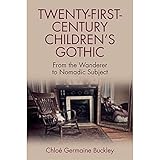Twenty-First-Century Children’s Gothic : From the Wanderer to Nomadic Subject / Chloé Germaine Buckley.
Material type: TextPublisher: Edinburgh : Edinburgh University Press, [2022]Copyright date: ©2017Description: 1 online resource (232 p.)Content type:
TextPublisher: Edinburgh : Edinburgh University Press, [2022]Copyright date: ©2017Description: 1 online resource (232 p.)Content type: - 9781474430173
- 9781474430197
- 823.92099282
- PR830.C513 B78 2018
- online - DeGruyter
| Item type | Current library | Call number | URL | Status | Notes | Barcode | |
|---|---|---|---|---|---|---|---|
 eBook
eBook
|
Biblioteca "Angelicum" Pont. Univ. S.Tommaso d'Aquino Nuvola online | online - DeGruyter (Browse shelf(Opens below)) | Online access | Not for loan (Accesso limitato) | Accesso per gli utenti autorizzati / Access for authorized users | (dgr)9781474430197 |
Frontmatter -- Contents -- Acknowledgements -- Introduction: From Gothic Wanderer to Nomadic Subject -- 1. Un-homing Psychoanalysis through Neil Gaiman’s Coraline -- 2. Fleeing Identifi cation in Darren Shan’s Zom-B -- 3. Exiled Lovers and Gothic Romance in Jamila Gavin’s Coram Boy and Paula Morris’s Ruined -- 4. Relocating the Mainstream in Frankenweenie and Paranorman -- 5. The ‘Great Outdoors’ in the Weird Fiction of Derek Landy and Anthony Horowitz -- Conclusion: Francis Hardinge’s The Lie Tree and Beyond -- Works Cited -- Index
restricted access online access with authorization star
http://purl.org/coar/access_right/c_16ec
Outlines a new critical paradigm for reading children’s Gothic literature and filmThis is the first monograph that brings together the fields of Gothic Studies and children’s fiction to analyse a range of popular and literary works for children published since 2000. It offers a completely new way of reading children’s Gothic that counters the dominant critical positions in both Gothic Studies and children’s literature criticism. This book contends that the Gothic, as it is repurposed in children’s fiction, is a creative force through which to imagine positive self-transformation. It rejects the pedagogical model of children’s literature criticism, which analyses and assess works based on what or how they teach the child, and instead draws on the theories of Deleuze and Guattari, Rosi Braidotti and Benedict Spinoza to develop the theme of ‘nomadic subjectivity’.The book covers texts from popular culture, novels by much-neglected female writers, as well as more celebrated works: Frances Hardinge’s The Lie Tree, Neil Gaiman’s Coraline, Darren Shan’s Zom-B, Jamila Gavin’s Coram Boy, Paula Morris’s Ruined, Derek Landy’s Skulduggery Pleasant, Anthony Horowitz’s The Power of Five; as well as films such as Frankenweenie and Paranorman. This broad scope allows for clear demonstration of the broad relevance of nomadic subjectivity for children’s literature criticism.Key FeaturesChallenges the dominance of psychoanalytical approaches in children’s literature criticismSets out a new agenda for how to analyse children’s fictionCovers popular texts and literary works to break down assumptions about literary ‘value’ and worth that circulate in literary criticismCombines historical overview of children’s literature and the Gothic with analysis of recent fiction and criticism
Mode of access: Internet via World Wide Web.
In English.
Description based on online resource; title from PDF title page (publisher's Web site, viewed 29. Jun 2022)


